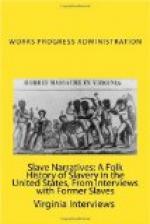“As you know the mother was the owner of the children that she brought into the world. Mother being a slave made me a slave. She cooked and worked on the farm, ate whatever was in the farmhouse and did her share of work to keep and maintain the Tolsons. They being poor, not having a large place or a number of slaves to increase their wealth, made them little above the free colored people and with no knowledge, they could not teach me or any one else to read.
“You know the Eastern Shore of Maryland was in the most productive slave territory and where farming was done on a large scale; and in that part of Maryland where there were many poor people and many of whom were employed as overseers, you naturally heard of patrollers and we had them and many of them. I have heard that patrollers were on Kent Island and the colored people would go out in the country on the roads, create a disturbance to attract the patrollers’ attention. They would tie ropes and grape vines across the roads, so when the patrollers would come to the scene of the disturbance on horseback and at full tilt, they would be throwing those who would come in contact with the rope or vine off the horse; sometimes badly injuring the riders. This would create hatred between the slaves, the free people, the patrollers and other white people who were concerned.
“In my childhood days I played marbles, this was the only game I remember playing. As I was on a small farm, we did not come in contact much with other children, and heard no children’s songs. I therefore do not recall the songs we sang.
“I do not remember being sick but I have heard mother say, when she or her children were sick, the white doctor who attended the Tolsons treated us and the only herbs I can recall were life-everlasting boneset and woodditney, from each of which a tea could be made.
“This is about all I can recall.”
Maryland
Sept. 7, 1937
Rogers
Richard Macks, Ex-slave.
Reference: Personal interview with Richard Macks,
ex-slave,
at
his home, 541 W. Biddle St., Baltimore.
“I was born in Charles County in Southern Maryland in the year of 1844. My father’s name was William (Bill) and Mother’s Harriet Mack, both of whom were born and reared in Charles County—the county that James Wilkes Booth took refuge in after the assassination of President Lincoln in 1865. I had one sister named Jenny and no brothers: let me say right here it was God’s blessing I did not. Near Bryantown, a county center prior to the Civil War as a market for tobacco, grain and market for slaves.
“In Bryantown there were several stores, two or three taverns or inns which were well known in their days for their hospitality to their guests and arrangements to house slaves. There were two inns both of which had long sheds, strongly built with cells downstairs for men and a large room above for women. At night the slave traders would bring their charges to the inns, pay for their meals, which were served on a long table in the shed, then afterwards, they were locked up for the night.




